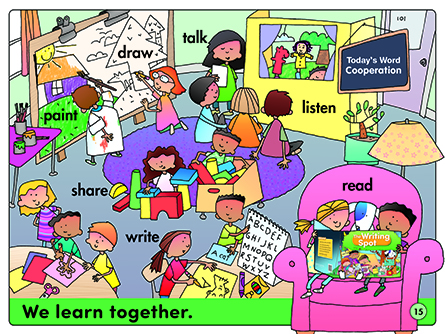Additional Activities
These activities offer options for continuing the learning in this unit. Whether your curriculum is skill-based or more open-ended, select the activities that are most appropriate for the children in your classroom. The Writing Spot is primarily a writing program, but writing can be integrated throughout your curriculum—in art, drama, reading, math, and science.
-
List long words that kids love.
The word “cooperation” is a very long word for young learners, and many children delight in knowing “big” words. With the children, create a list of long words—like Mississippi, hippopotamus, chrysanthemum—and clap out the syllables. Post the list and help the children add more long words as they come across them in reading or conversations.
-
Write the rules for playground games.
Play outdoor games that call for teamwork. Back in the classroom, write simple rules for the games and talk about them.
-
Play a game to show the importance of rules.
Announce that the aisles of your classroom are make-believe streets, and invite children to be cars, trucks, and buses. All vehicles will be on the “streets” at the same time. The only rule is that they may not run (exceed the speed limit). When you say “go,” all vehicles take to the streets. Before long, you will see your little cars, trucks, and buses bumping into each other and backed up in traffic jams. Have everyone return to their desks (garages). Explain that they will do this activity again, only this time, you will be a police officer, and they must follow certain rules. When you hold up a stop sign, they must stop. When you hold up a green “go” sign, they may go. Insert whatever verbal directions you feel necessary to keep the second “outing” orderly. Use this activity to launch a discussion about rules. Have children compare what happened in both situations.
-
Form daily cleanup teams.
At the end of each day, allow for cleanup time. An organized classroom makes cleanup easier. Make sure that there is a place for everything, and that children know where things go. Assign cleanup teams to certain tasks, and consider having only one team working at a time.
-
Discuss being trustworthy during work and play.
Add the word “trust” to the word wall. Talk with the children about what it means to trust someone. Share these examples: We trust people to be on time; our pets trust us to take care of them; we trust our teacher to help us learn. Then have children write the word “trust” at the top of a piece of paper and draw a picture about being trustworthy. Use "________ Me!" for this activity.
-
Play a game to practice being polite.
Make a set of cards that have a picture on one side and are blank on the other. Make all the cards different except for one duplicate. Each child is given a card that is placed facedown on the desk (no peeking). One child shows his or her card to the class, and then goes from person to person asking, “May I see your card?” That person responds with, “Yes, you may,” and turns over the card for everyone to see. If it is not a match, the first child says, “Thank you,” and moves on to the next child. Play until the duplicate card is found. If it is a match, the children say, “We have a match!”
-
Use teamwork for work and play.
Early in the school year, divide the class into color-coded teams. Give each child a sturdy, laminated bracelet made from colored construction paper, with his or her name clearly printed on it. Find a special place in the classroom to store the bracelets. Whenever you plan a team activity, have children find their bracelets and get into their color-coded teams.
-
Create a “helper-buddy” chart.
Everyone is good at something (writing, reading, drawing, numbers, computer, passing things out, sound effects, and so on). Assess each child’s strengths. Make a “helper-buddy” chart showing what each child can help with. (Be sure every child is on the list.) Then, when children get “stuck” while doing an activity, they can look at the chart and ask a helper-buddy for help.
-
Be good listeners during work and play.
For this ongoing activity, you will need a special object, like a big feather. Explain that this object has an important role in your classroom. Whenever a person holds up the object, everyone else must be quiet and listen to what that person has to say. Use this object whenever you plan an activity that requires a lot of listening.

